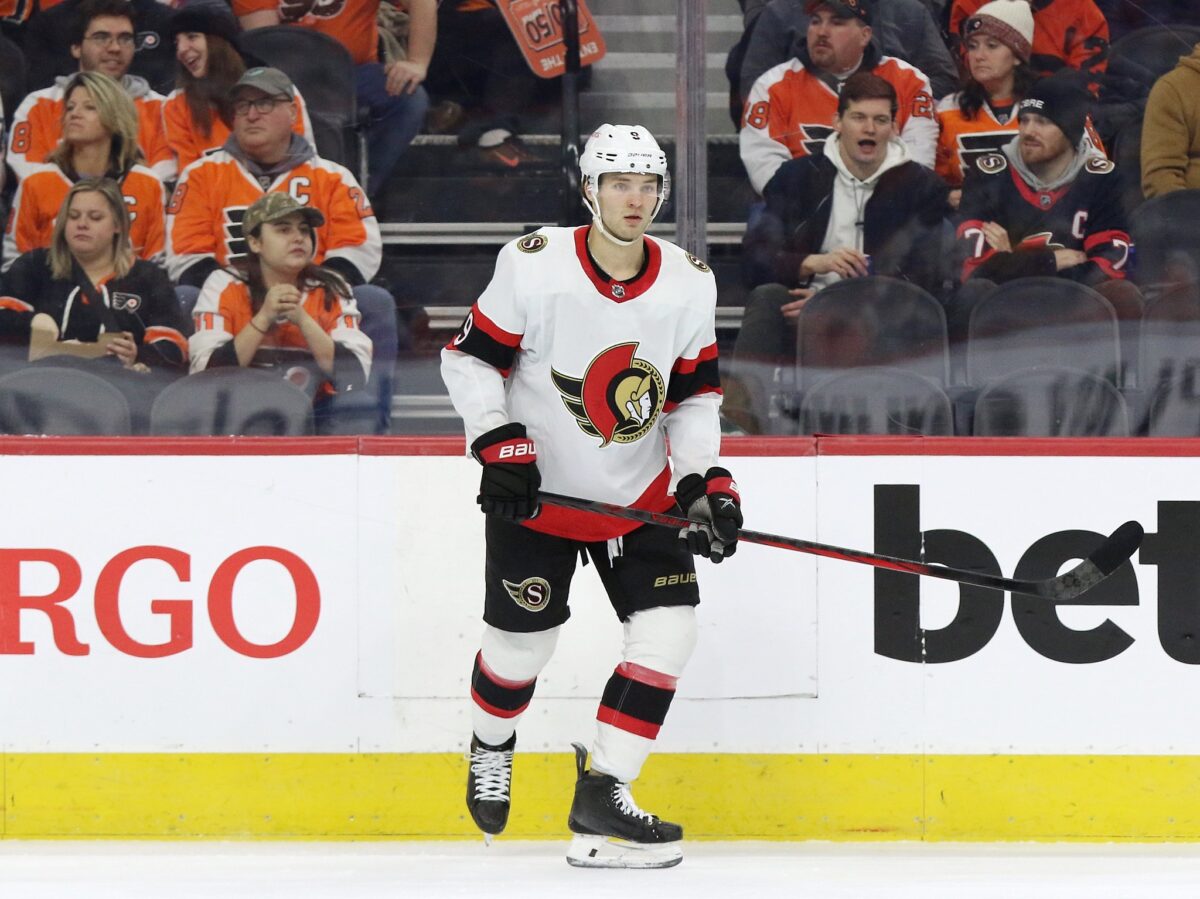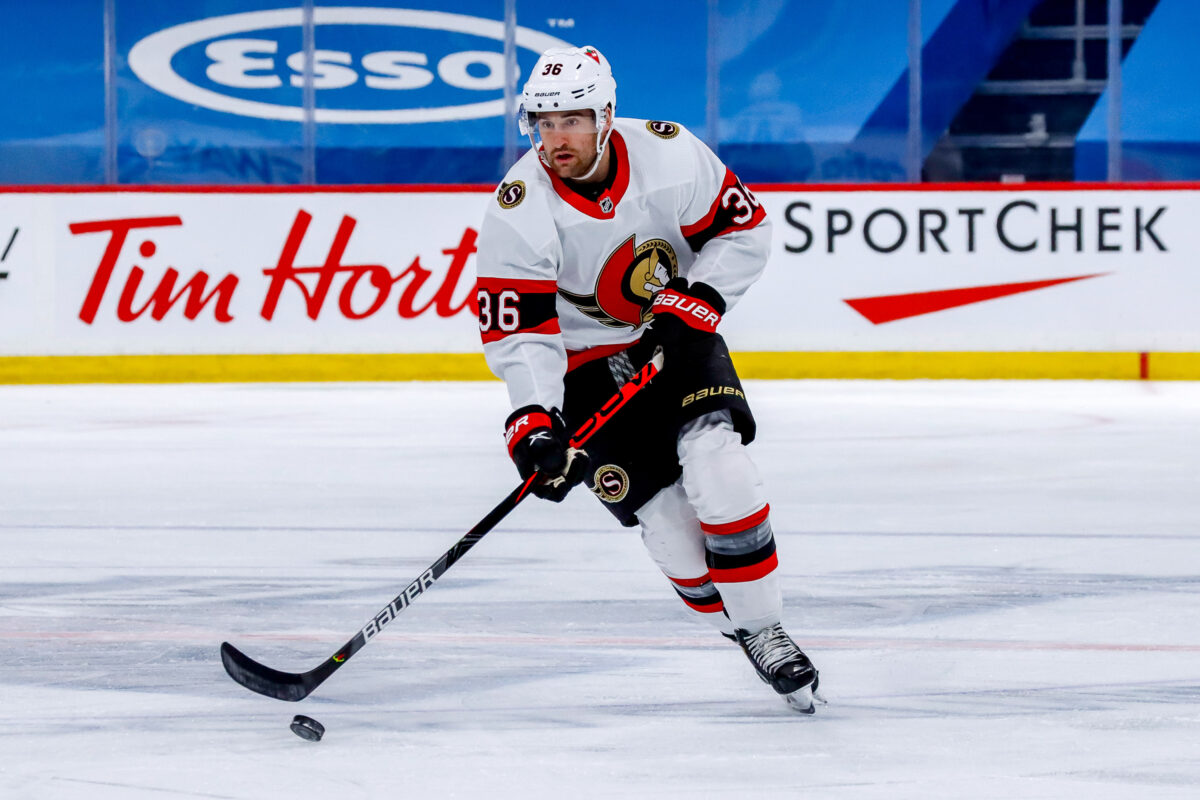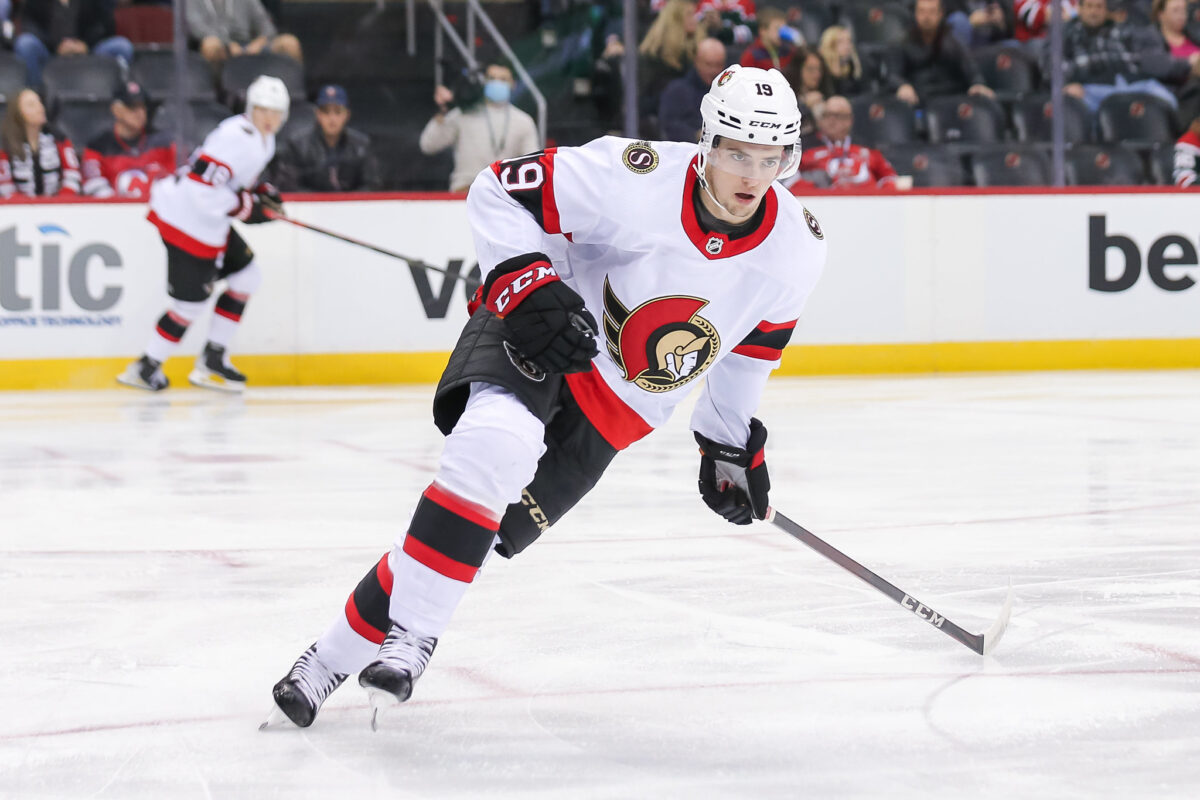Colin White was back in the news last week. The former first-round pick was placed on waivers by the Pittsburgh Penguins and subsequently claimed by the Montreal Canadiens, who view him as a solid depth addition. It was a painful reminder of just how far the Senators’ once-prized prospect has fallen since he scored 41 points in 2018-19. Since then, his career has been in steep decline, including a buyout, a league-minimum deal, and some time in the minors.
However, the most painful part of White’s career is how similarly it mirrors Josh Norris’. One of the prized pieces in the Erik Karlsson trade, the former American Hockey League (AHL) All-Star has struggled since returning from a significant injury and, against the Nashville Predators on Feb 27, 2024, he was pushed into the net and immediately went to the bench, clutching his left shoulder. Although he’s still on pace for 45 points this season and is just 24 years old, it’s getting harder and harder to justify his limited production, given his monstrous contract and constant injuries. Unless something changes, Norris is on a similar path, which is terrible for the Senators.
Norris’ Up and Down Career in Ottawa
There were several reasons why the Senators targeted Norris in the Karlsson deal. He was a 2017 first-round pick who rose up the draft rankings thanks to an impressive performance at the NHL Draft Combine and a strong finish with the United States National Team Development Program (NTDP), finishing first with 27 goals and 61 points. His speed, two-way ability, and toughness drew comparisons to Logan Couture following his selection, and he looked to become a solid second-line center in the NHL. But his connection to Ottawa’s 2018 first-round pick and future face of the franchise, Brady Tkachuk, was likely the deciding factor. The pair played together for three seasons before the trade and developed a strong friendship.
Related: Revisiting the Sharks’ Erik Karlsson Trade
Norris quickly became one of Ottawa’s most promising prospects. He finished the 2019 World Juniors with three goals and six points, and when he joined the AHL Belleville Senators, he immediately clicked with Alex Formenton and Drake Batherson. With them on his line, he led the team with 31 goals and 61 points as a rookie – he was named the AHL Rookie of the Year and was a First All-Star Team. He made his NHL debut in 2020-21, and his 17 goals and 35 points earned him a spot on the All-Rookie Team along with Kirill Kaprizov and Jason Robertson. It also landed him fourth in Calder Trophy voting as the league’s best rookie.
By his second season in the NHL, Norris was one of the Senators’ core players, putting up an incredible 35 goals and 55 points in 66 games in 2021-22. With his entry-level deal expiring that summer, general manager Pierre Dorion locked him up to an eight-year, $63.6 million contract worth $7.95 million per season. It was a bit of an overpay, but it was obvious that the team was banking on him to break out in the coming seasons and believed he was worth the investment.
However, Norris also came with some injury concerns, specifically with his shoulder. After putting up 23 points in his freshman season with the University of Michigan, he injured his shoulder at the 2019 World Juniors, which required surgery and sidelined him for the rest of the season. When he returned, he signed his entry-level deal and didn’t look out of place at the pro level, but then, in 2022-23, he re-injured it just five games into the NHL season and didn’t want to undergo surgery with a long recovery. Instead, he sat out three months doing rehab on it, making his return on Jan 18, 2023. He managed just three games before re-injuring it, and this time, surgery was inevitable, and he was forced to sit out the remainder of the season.

So, when Norris tweaked something right before training camp, fans were nervous that their top center was once again going to miss significant time. Thankfully, he only missed three games before returning to the lineup. However, he hasn’t had that same level of competitiveness since his return. After establishing himself as a top goal scorer, he’s gone on long slumps this season – his longest is 14 games. He still has 30 points in 48 games, but that’s not worth nearly $8 million a season. He was recently demoted to the third line, where he was reunited with Batherson, who has also struggled this season, and now Norris has three goals in his last two games. But the question remains – is it enough?
White’s Senators Tenure Mirrors Norris
Like Norris, White was also a first-round pick who immediately looked like a steal. Drafted by the Senators 21st overall in 2015 with the second of two first-round picks, White slipped down a couple of spots from his projected spot thanks to a wrist injury and a bout of mono in his draft year. Defensively, however, there were few players better, and several analysts compared him to Curtis Lazar, one of Ottawa’s top prospects at the time. There was little doubt that he had legitimate top-nine potential and would be a reliable NHLer for years to come.
In 2015-16, as a freshman at Boston College, White showed that he might have a bit more offensive upside than everyone predicted, finishing second in team scoring with 43 points in 37 games and earning both the New England and Hockey East’s Rookie of the Year awards. On the American 2016 World Junior team, he scored three goals and seven points while playing an effective bottom-six role. But it was in 2016-17 that White really shone. On his second trip to the World Juniors, he led the Americans with seven goals and helped the team win the gold medal for the first time since 2013.
White joined the Senators for the 2016-17 Eastern Conference Final and was given a roster spot for the following season, but he didn’t get off the ground running, playing just 21 NHL games and putting up six points while spending the rest of the season in the AHL. Then, in 2018-19, he broke out, scoring 41 points in 71 games with the Senators as a rookie. With his entry-level deal expiring, Dorion signed the promising young center to a six-year, $28.5 million deal with a cap hit of $4.75 million per season, the biggest deal the team had signed since Bobby Ryan’s nearly $8 million in 2013-14. It was seen as a great value for a player who could play top-six minutes almost immediately and well worth the risk despite his lack of previous production.

Unfortunately, the deal almost immediately fell flat. White followed up his breakout rookie season with 23 points in 61 games, then put up 18 in 45 games the following season. In 2021-22, he sustained a shoulder injury during the preseason that limited him to just 24 games, during which he scored 10 points. That was enough for the Senators, who decided to place their once-prized center on unconditional waivers for a buyout. He was just 25 years old.
Since his release, he’s bounced around the league but has never been able to match his rookie totals. Shoulder injuries are tough to overcome; Norris is a perfect example of how long they take to recover and rehab. But seeing how White’s career has turned out after sustaining a similar injury is concerning, and given what fans have seen so far, it looks like Norris is on the same track.
Senators Still Have a Chance to Save Norris
The Senators need to navigate this situation very carefully. When Norris is healthy, he’s a proven 30-goal scorer with history and chemistry with the roster that few others can boast about. While that still may not be worth nearly $8 million a season, it is, at the very least, justifiable.
The first thing the team can do is put Norris in a position to succeed. White was placed in a top-six role before he was ready, and although he showed promise, he was never going to reach those lofty expectations. He was projected to be a solid two-way third-line center, and even a move to the wing hasn’t helped him become more than that. At one point, Norris looked like a top-line center, but he was never expected to be one, and the Senators need to realize that. He thrived in the AHL alongside two quick offensive wingers and has looked good when placed back with them. The team must lean into that. Give him a chance to play with players he has had success with in the past.

Secondly, the Senators need to give Norris time. With White, the Senators immediately cut ties when he wasn’t living up to his contract, and for a small-market team, they needed to make every dollar count. Even though it was likely just business, that kind of move can do a number on a player’s mental health and confidence, which could be why White has struggled to get back to a 45-point pace. Norris is still just 24 years old and has plenty of time to get back on track. He just needs to stay healthy and be given time to fully recover.
Norris Still Has a Murky Future
That being said, Norris doesn’t have unlimited time in Ottawa. If he isn’t able to pick up his game soon, management may have to make the difficult decision to get rid of his contract by any means necessary. It’s not the first time the Senators have been in this mess – Matt Murray was sent down to the AHL after struggling following an injury in Nov 2021 and was soon followed by Michael Del Zotto, who played just 10 games with the Senators after signing a two-year, $4 million deal the previous summer – but if they chose to do the same thing with Norris, it would be by far the most egregious.
If a decision is necessary, trading Norris is the better option, even if it’s not an ideal return. Teams have reportedly asked about him, and David Pagnotta of The Fourth Period reports that, although he’s not being shopped, general manager Steve Staios is still listening to offers.
Norris’ trade value is the lowest it’s arguably been since he was acquired from the Sharks, so the return for him would be underwhelming, to say the least. Thus, it may be better to wait and see if putting Norris in a position to succeed is beneficial in the long term. If he can find his rhythm again on the third line, maybe he can move up and become that 70-point player that the Senators hoped he would be when they put pen to paper. Otherwise, Ottawa will simply be repeating history.
